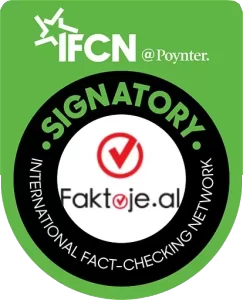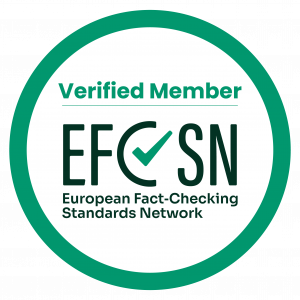The communist symbols on the mosaic above the entrance of the National History Museum were removed 30 years ago and not during the recent restoration process, as is being incorrectly reported by some portals. Faktoje managed to get hold of the decision taken my Meksi Government back in 1993.
Esmeralda Topi
The restoration of the mosaic on the facade of the National Historical Museum is being accompanied by controversy regarding the missing communist symbols in this work of socialist realism. “Should they have removed the star from Tirana mosaic during the restoration?”, this is a question Drita Newspaper portal asked its Facebook followers, sharing two images of the mosaic on the facade of the National Historical Museum. One of the photos shows the mosaic with communist symbols on it, while the other one shows the same mosaic without the star and the red book, which represented the works of dictator Enver Hoxha.

Facebook post from Gazeta Drita
The post of Drita Newspaper was made on May 21 and has received hundreds of reactions, while dozens of users have recently shared on their Facebook profiles the image of the ‘Albania’ mosaic, before and after the retouching of the Communist symbols.
Beyond the healthy debate whether or not socialist realism art should be retouched, because of the ideology it conveys, there is a need to explain to the public that the recent restoration should not be blamed for changing the originality of the mosaic.
Our verifications show that the process of retouching the communist symbols took place about 30 years before this necessary restoration began to save the work.
Mosaic retouching since 93′
“Faktoje” managed to obtain a copy of the decision bearing the signature of Dhimitër Anagnosti, the former Minister of Culture in the cabinet led by Aleksandër Meksi”, on November 15, 1993.

Decision no. 554, dated 15.11.1993 of the Council of Ministers
The report accompanying the decision shows that the removal of the Communist symbols was done after a consultation held in the Ministry of Culture with historians, architects and creators in the field of art and culture.

Based on the discussions, it was concluded to:
- Remove the star from the National Flag
- Remove the big star from the background of the mosaic, as a symbol of communism
- Remove the red book representing E. Hoxha’s written works from the hand of the worker on the mosaic.’, assigning Agim Nebiu, one of the four authors of the work to do the removal.
Contacted by Faktoje, Agim Nebiu tells us how the decision was made to replace the communist symbols in the work 30 years ago.
“It was 1993. An emergency meeting was held at the ministry. During the discussions I proposed to remove the two stars and replace the red book with a jacket. This proposal was welcomed, it saved the mosaic, which with the mentality of that time was in danger of being removed altogether”., says Nebiu.
Restoration of the “Albania” mosaic
The iconic facade mosaic of the National Historical Museum is considered one of the best works of late Albanian socialist realism. Established in 1981, it displays on the surface of 565 m2, some of the most important moments of the country’s history, from antiquity to the communist era. Over the years, the work had suffered damages, which became even more visible after the earthquake in November 2019.
The European Union started the restoration of the mosaic as part of the EU4Culture project, implemented by the United Nations Office for Project Services in cooperation with the Ministry of Culture of Albania. This project focuses on the renovation and revitalization of cultural heritage objects, which were damaged by the earthquake, with a total budget of 40 million euros. From this budget, about 1 million euros enabled the restoration of the ‘Albania’ mosaic.
Archaeologist Agron Islami was part of the mosaic restoration team. Contacted by Faktoje, he says that the works in the workshop set up for the restoration of the work lasted two years.
“Difficult interventions were made on 50-60% of the mosaic’s surface. We had to detach the old material from the support and restore the new testers again one by one for the Mosaic. We divided the work into segments and we worked on each segment by replacing the irons and rusty pieces with new ones,” says Islami while also commenting on the controversies raised in social networks and the media regarding the retouching of communist symbols.
“In 1993, the three symbols of the mosaic were retouched. But now it is not about retouching, but about restoration. For me, even the intervention of 93′ is a historical fact. Tomorrow, they might say that this mosaic was born in 1981, in 1993 it was retouched and in 2023 it was restored.”, he claims, clarifying the difference between the two concepts, retouching and restoration.
“I am a restorer and retouching is a different concept from restoration. The retouching of the Mosaic was done in 1993, it is positioned in those 565 m2 of mosaic with its own history, which I cannot change as a restorer”, concludes his comment Mr. Islami.
The inauguration of the restored Mosaic took place on the evening of May 17, in Skënderbej Square. The ceremony was part of Europe Week celebrations and brought together representatives of the EU Delegation, the Ministry of Culture, the UN, UNOPS, cultural heritage specialists, other high officials and authors of the Mosaic.
Note:
On May 26, 2023, Drita newspaper’s Facebook page corrected the text after the verification of the news by Faktoje. The reported news’ original assessment was latter changed on Facebook.






